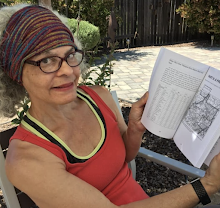All of the 2"x2" tiles were in place and I cut up some tiles to fit around the electrical sockets. But there were still 124" of blank 1/2" spaces at the edges of the colorful tiles and the adjacent cabinets and about 74" of 1" blank spaces under the cabinets and microwave oven.
This morning, I took two 5 pound pieces of clay off a 25-pound block of red 50/50 clay.
Then I rolled the pieces into 15"x10" pieces to fit into metal cookie sheets.
Now to carefully measure the length of the individual pieces I needed, plus about 10% to account for shrinkage. Since 1/2"x4" pieces were needed, I cut them at about 3/4"x4.5" strips.
Clay cut into 1/2"x4" strips in this cookie sheet, and 1/2"x2" strips in another sheet, and 1"x1" strips in another.
Cookie sheets were put into a 190-degree oven to dry out for 2 hours until they were mostly dry.

A damp sponge smooths out the edges of cut tile strips. Sharp edges will become like glass knives after firing if not smoothed out aforehand.

a damp sponge ensures that the tops of the clay strips are not sharp.

The partially-dried sheet of clay strips is ready for firing.

Here, the dried strips are moved from the cookie sheet onto a kiln shelf. The pieces are crowded together on the shelf so little space exists between the pieces.

Painting combination of black-colored glazes. Two layers of glaze. Yes! I did not fire the clay in the kiln before glazing! This can be dangerous, for if the first-time fired clay explodes in the kiln then glaze chunks will fuse to the sides of the kiln - and that's REAL BAD. Conventional wisdom and class teaching dictates that clay must be dried and fired in a kiln to at least 1860 degrees (cone 06) before painting a color glaze on the pieces and firing them a second time. But I didn't want to wait that long and decided to do all of the steps at one time. The danger in doing this is immense, for if one of the clay strips is not dry enough, or has an air pocket in it, it will explode in the kiln and the glaze (which essentially is glass) will adhere to the walls and shelves of the kiln. That would render the kiln unusable. So I took the chance anyway!

Glazed clay strips are ready for the kiln.

The glazing was done next to the new sink.

Filling the kiln with about 7 shelves full of handmade tiles.
I turned all three kiln heater controls to "low" and let them "cook" for a few hours while I went to the store. Coming back, I checked to make sure there had been no explosions - and there hadn't - so I turned the kiln controls up to "HIGH" and set the timer for 5 hours. A "cone" is a small piece of hardened clay that matches the type of clay used. The cone is fit inside the heater mechanism; when the cone gets hot enough, it bends, thus shutting off the heater to stop the "cooking." The kiln uses "cones" to determine when the load has "cooked" enough time, but having a timer is a backup in case the cone method doesn't work. So off I went with the kiln cooking, to enjoy my weekend with my main squeeze.









No comments:
Post a Comment